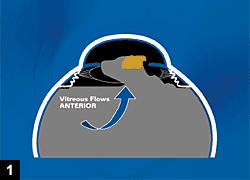Appropriate technique and settings prevent and minimize vitreous loss
 Uday Devgan |
We’ve all been there. A case is going relatively well, and then we notice a break in the posterior capsule. How can we optimize the situation in order to prevent or minimize vitreous loss and give the patient the best outcome? Using the appropriate technique and settings on our phaco platforms can allow complete removal of the cataract and minimize vitreous loss in the presence of a ruptured posterior capsule.
Dr. Howard Fine has taught me the three cardinal signs of a ruptured posterior capsule, which I remember as the 3 R’s: room, rebound loss and resistance to phaco.
Room refers to the increase in room within the eye due to a deepening of the posterior chamber after capsule rupture.
Rebound loss refers to the inability of the nucleus to rebound back to its central location after manipulation with the phaco probe or second instrument.
Resistance to phaco refers to the inability of the phaco probe to emulsify the cataract due to prolapsed vitreous blocking the phaco tip.
When we notice any of these cardinal signs of a ruptured posterior capsule, it is important to immediately change our technique and phaco settings in order to minimize or prevent vitreous prolapse.
Steps to prevent vitreous prolapse
The first step must be moving to foot position one (irrigation without aspiration) and keeping the phaco probe inside the eye. While maintaining the irrigation, viscoelastic can then be injected via the paracentesis to prevent collapse of the anterior chamber when the phaco probe is withdrawn. The most common mistake that surgeons make is allowing collapse of the anterior chamber when they notice a break in the posterior capsule.
By creating a pressure gradient with low pressure in the anterior chamber and higher pressure in the vitreous chamber, prematurely withdrawing the phaco probe causes an increase in the vitreous prolapse (Figure 1). To prevent this pressure gradient, it is important to fill the eye with viscoelastic, preferably under the remaining nuclear pieces, in order to create a barrier effect and more importantly to increase the anterior chamber pressure to prevent vitreous prolapse (Figure 2).
This one simple move, injecting viscoelastic under the remaining nuclear pieces before pulling the phaco probe out of the eye, is the most important step to prevent or minimize vitreous loss in the presence of a compromised posterior capsule.
|
|
Images: Devgan U |
Fluidics
For the fluidics, it is important to create a stable eye and at the same time prevent hydration of the vitreous and posterior displacement of the remaining nuclear pieces. The fluidic parameters that are easily changed are bottle height, aspiration rate (for a peristaltic system) and the maximum vacuum level.
The bottle height should be lowered to prevent too high of an infusion pressure, which could send nuclear fragments posterior and hydrate the vitreous. Choosing a bottle height that is approximately 1 foot above the patient’s eye will allow sufficient infusion while being gentle. The exact number of this setting will vary based on the height of the patient’s head in your operating room.
The flow rate should be decreased to achieve a slow-motion effect, approximately 20 cc/minute. This will allow sufficient flow for continued nuclear removal without creating too much turbulence within the eye.
The vacuum level in a peristaltic system is only achieved on occlusion of the phaco tip. When the capsule is broken, there is a risk of aspirating vitreous, which will cause immediate occlusion and result in the “ding, ding” sound heard on most phaco platforms. We want to prevent
aspiration of the vitreous by the phaco probe; the phaco probe is unable to remove vitreous – a proper vitrector/cutter is required. Lowering the maximum vacuum to approximately 100 mm Hg to 150 mm Hg will allow us to remove the remaining nuclear pieces while posing less risk of high pressure and tension on the prolapsed vitreous.
Throughout the removal of the last bits of the nucleus and cortex, it is important to inject more viscoelastic to support the nucleus, create a barrier effect and prevent further prolapse of the vitreous. The saying that I teach my residents is, “Viscoelastic is cheaper than vitreous – use as much as you need.”
In my next column, we will delve into the techniques and settings to perform an anterior vitrectomy.
For more information:
- Uday Devgan, MD, FACS, is in private practice in Los Angeles, chief of ophthalmology at Olive View-UCLA Medical Center and an assistant clinical professor at the Jules Stein Eye Institute at the University of California, Los Angeles. He can be reached at the Maloney Vision Institute, 19021 Wilshire Blvd. #900, Los Angeles, CA 90024 U.S.A.; +1-310-208-3937; fax: +1-310-208-0169; e-mail: devgan@ucla.edu; Web site: www.maloneyvision.com.


